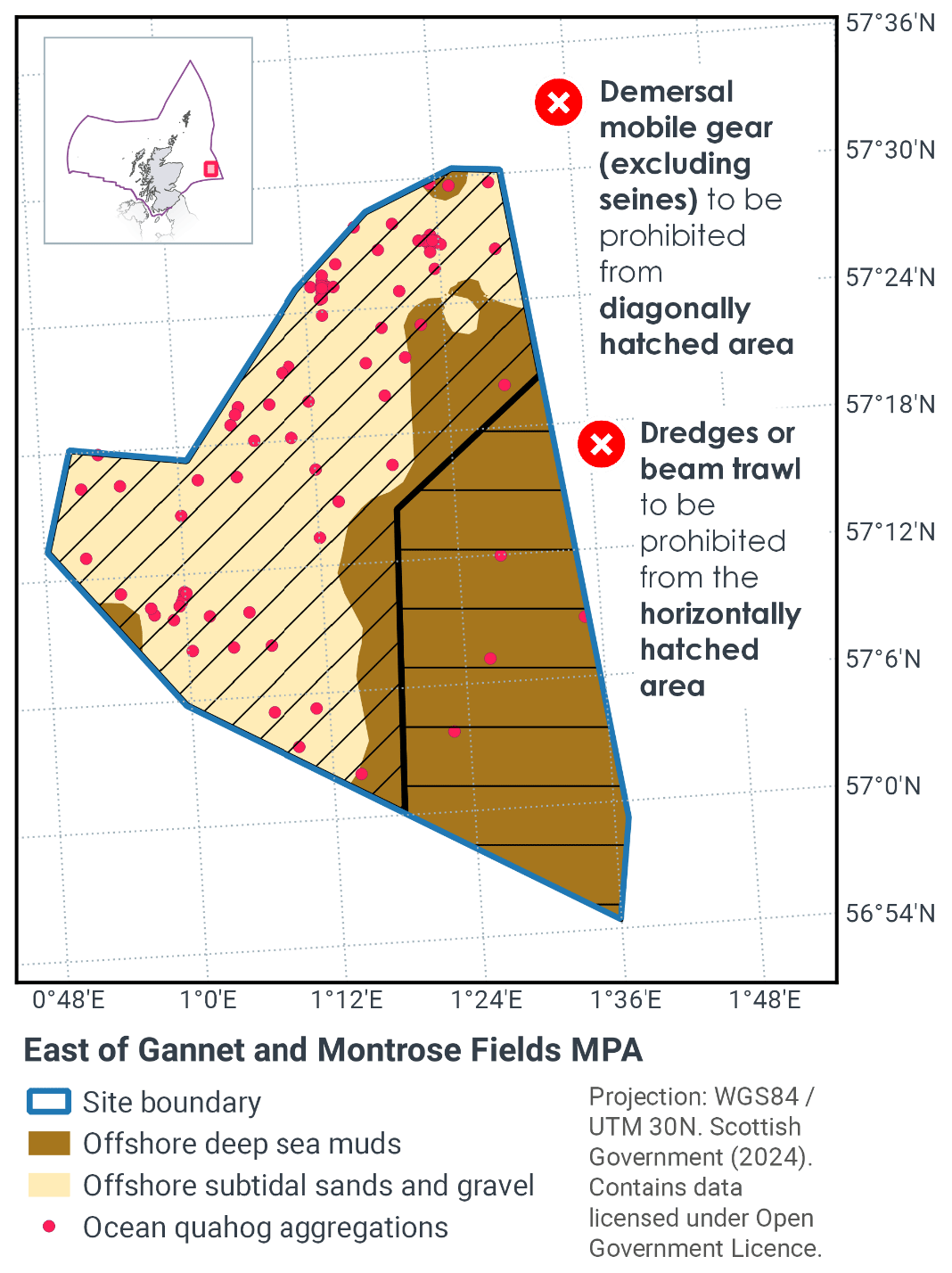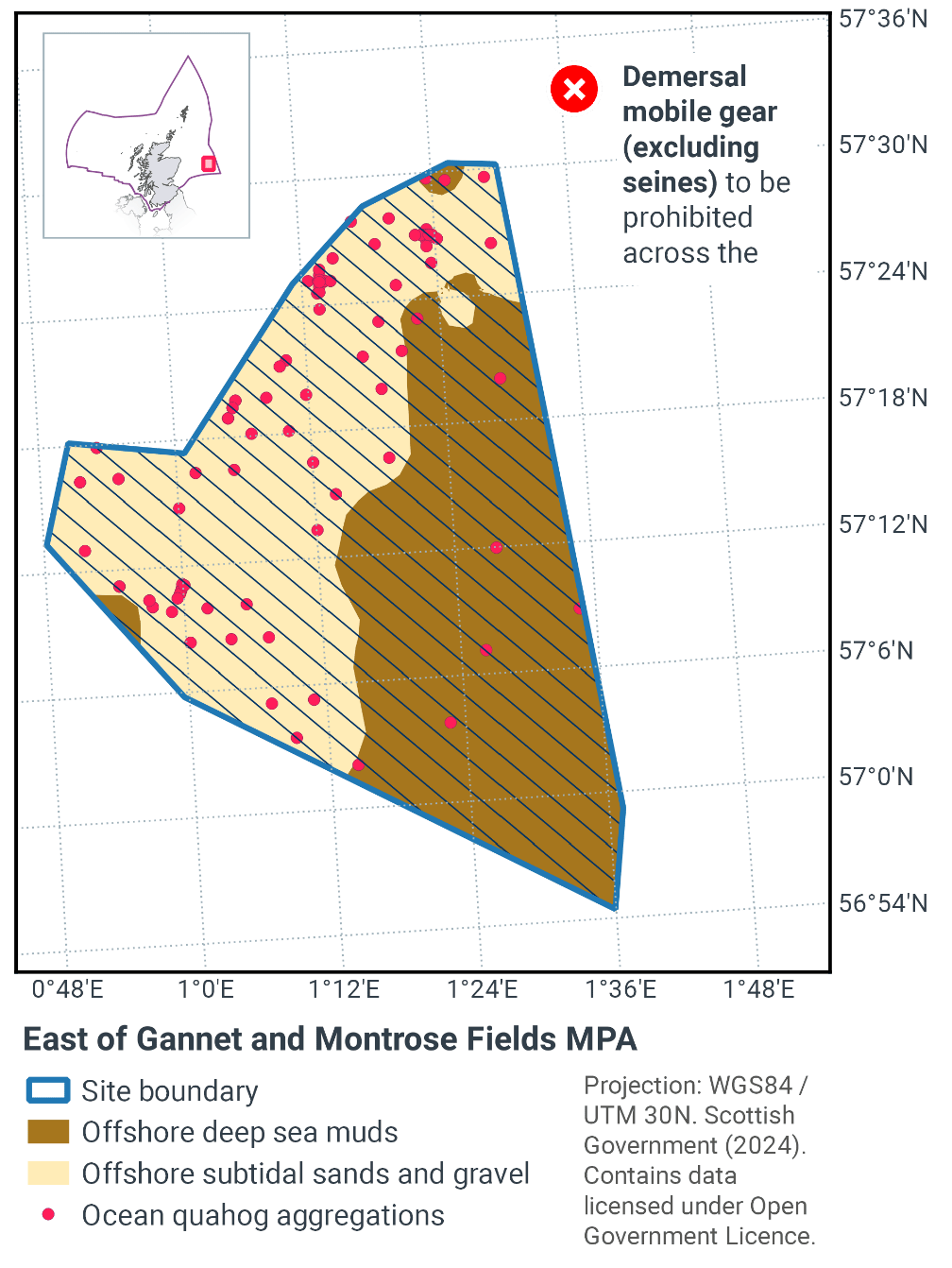Draft Fisheries Assessment – East of Gannet and Montrose Fields NCMPA: Fisheries management measures within Scottish Offshore Marine Protected Areas (MPAs)
These assessments look at the fishing activity occurring within each offshore MPA and SAC and assess the potential impacts of this activity on the protected features within each site. This assessment is for East of Gannet and Montrose Fields NCMPA.
5. Management Options
5.1 Overview of management options
Management measures are being considered by Scottish Ministers and any decision as to which measures ought to be taken forward will follow upon a statutory public consultation exercise. Any such decision will also be taken in line with the Scottish Ministers obligations in relation to the exercise of their functions.
The socioeconomic impacts and costs of each management option (no additional management, zoned management, and full site exclusion) have been assessed within the Socio-Economic Impact Assessment (SEIA) and Sustainability Appraisal (SA) and are not discussed within this Fisheries Assessment. Nor are other considerations, statutory and non-statutory, which the Scottish Ministers may be required to take into account when assessing whether the imposition of a particular measure is appropriate.
This section assesses the suitability of the management options solely in light of the conservation objectives, biological characteristics of protected features, and current activity levels for East of Gannet and Montrose Fields NCMPA.
5.2 Assessment of management options
5.2.1 No additional management
The assessment identified that management measures would be required to avoid hindering the achievement of the conservation objectives from mobile demersal gear (with the exception of demersal seines) for the site. Thus, the option of no management is not considered further.
5.2.2 Zoned Management
Zoned fisheries management measures would be introduced to reduce/limit pressures. Due to the potential impacts of demersal trawls on the features of the site, management will be introduced to reduce the risk of the conservation objectives not being achieved. This would involve:
1. Dredges and beam trawls to be prohibited across the whole site (100%); and
2. Demersal mobile gears (excluding seines) to be prohibited from a proportion of the site (65%; see Figure 4).
There would therefore be no zonal measures for demersal seines, as the need for additional management for this fishing type was not identified during the assessment or from JNCC advice.
In this zoned management option, 100% of the site would be closed to dredge and beam trawls, and all other demersal mobile gears (excluding demersal seine nets) would be prohibited from 65% of the site (in the northern section). This option provides full protection to the area of ocean quahog aggregations and their supporting sands and gravels habitat in the north of the site where they occur in greatest numbers. Furthermore, this area is where the tall seapen (Funiculina quadrangularis) and the slender seapen (Virgularia mirabilis) are found. F. quadrandularis is considered to be particularly sensitive to fishing activity, and it is mainly associated with the sandy sediments in the north of the site. These characterising species would therefore be protected from damaging fishing gears under this option. The southern part of the site (35%) would remain open to demersal trawls for this option, which is where the majority of the activity associated with this gear type occurs. Although the available evidence indicates that all types of demersal trawls pose a risk to the offshore deep-sea muds feature, which occurs in this southern section of the site, the most damaging gear types are deemed to be those that penetrate into the seabed, such as dredge and beam trawls. Under this option, both of these gear types would be prohibited from this southern section of the site, thereby reducing the risk to the offshore deep-sea mud feature and the characterising seapens found in this habitat (Pennatula phosphorea and Virgularia mirabilis). Overall, this management option was considered sufficient to enable process to be made towards achieving the conservation objectives for offshore deep-sea muds, ocean quahog aggregations and the supporting offshore subtidal sands and gravels features.
The zoned management approach would contribute to the ecological coherence of both the Scottish NCMPA Network and the broader OSPAR NCMPA Network.
Having considered the conservation and fisheries management advice from the statutory nature conservation bodies, and the wider evidence contained within this assessment, Scottish Ministers consider that zoned management measures would not hinder the achievement of conservation objectives for East of Gannet and Montrose Fields NCMPA, rather they would further those objectives.

5.2.3 Full site exclusion
Full site exclusion would remove/avoid all pressures associated with fishing activities using demersal mobile gears (excluding seines) through prohibiting the use of the gear across the whole site throughout the year (Figure 8). No prohibitions are considered for demersal seines, as the need for additional management for this type of fishing was not identified during this assessment.

Removing all pressures associated with demersal trawl gears, by prohibiting the use of demersal trawls across the whole site, would support the recovering to favourable condition for offshore deep-sea muds, ocean quahog aggregations, offshore subtidal sands and gravels so that the extent is stable, or increasing; and structure, function, quality and the composition of characteristic biological communities are such as to ensure they remain in a condition which is healthy and not deteriorating within East of Gannet and Montrose MPA.
Full site year-round exclusion of mobile demersal gear (excluding seines) would contribute to avoiding the broader decline of Offshore deep sea muds, Ocean quahog aggregations, Offshore subtidal sand and gravel features and retaining the ecological coherence of both the Scottish NCMPA Network and the broader OSPAR NCMPA Network.
Given the available evidence, Scottish Ministers consider that full site exclusion would not hinder the be achievement of the conservation objectives for the East of Gannet and Montrose Fields NCMPA, rather it would further those objectives.
5.3 Management options conclusion
Scottish Ministers consider that adopting no additional management measures for mobile demersal fishing would, or might, hinder the achievement of the conservation objectives for East of Gannet and Montrose Fields NCMPA.
Scottish Ministers consider that both zoned management measures and full site exclusion option for demersal mobile fishing, outlined above, would further the conservation objectives of the site.
The decision on which management option is to be taken forward will be taken in the light of all relevant duties incumbent upon the Scottish Ministers in relation to the exercise of their functions and following upon a statutory public consultation exercise in which views on the options under consideration are invited.
Contact
Email: marine_biodiversity@gov.scot
There is a problem
Thanks for your feedback